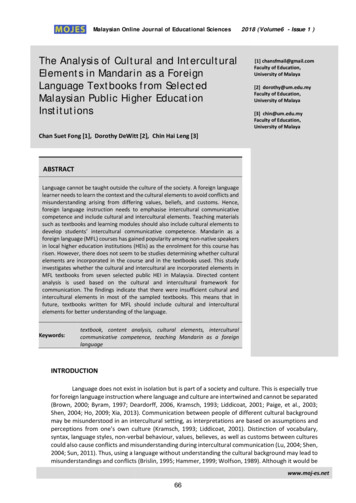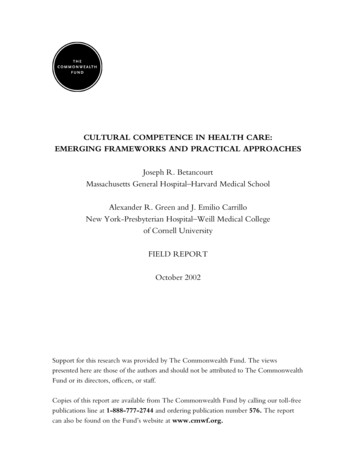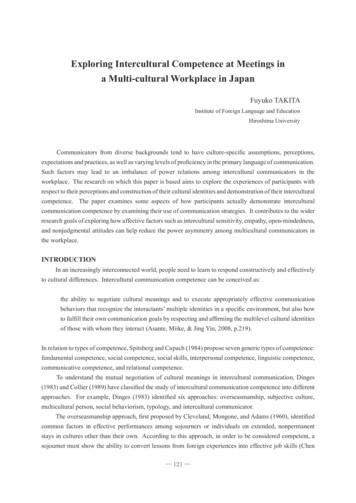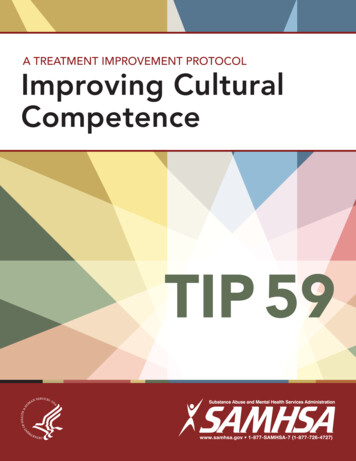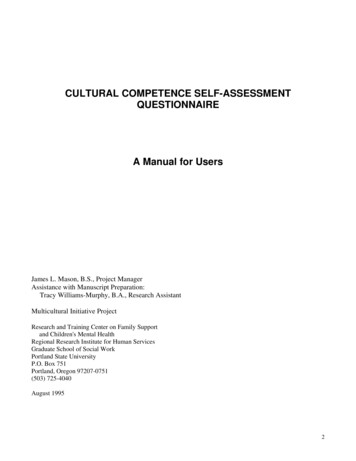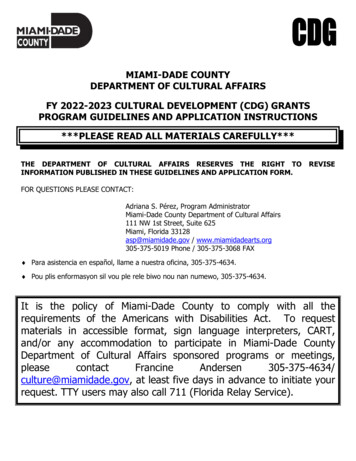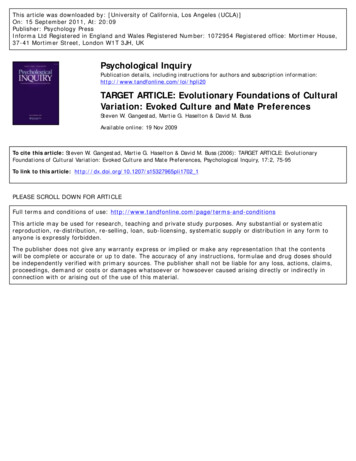
Transcription
Cultural Competence and Language AssistanceThis communication was printed, published, or produced and disseminated at U.S. taxpayer expense.
Course IntroductionWelcomeWelcome to the course on Cultural Competence and Language Assistance! I am Neha, and I will be your guidethrough this training.This course defines culture as it relates to consumers and highlights the importance of cultural and linguisticcompetence when you assist them with eligibility, enrollment, and post-enrollment issues.
DisclaimersYou need to be aware of these training disclaimers.Assister Training Content:The information provided in this training course is not intended to take the place of the statutes, regulations,and formal policy guidance that it is based upon. This course summarizes current policy and operations as ofthe date it was uploaded to the Marketplace Learning Management System. Links to certain source documentshave been provided for your reference. We encourage persons taking the course to refer to the applicablestatutes, regulations, CMS assister webinars, and other interpretive materials for complete and currentinformation.This course includes references and links to nongovernmental third-party websites. CMS offers these links forinformational purposes only, and inclusion of these websites shouldn't be construed as an endorsement of anythird-party organization's programs or activities.Coronavirus (COVID-19):This training does not address COVID-19-related guidance or related requirements for assisters. CMS willcommunicate applicable information to assisters and assister organizations through separate channels. To learn more about how we're responding to coronavirus, visit HealthCare.gov/coronavirus/. For preventive practices and applicable state/local guidance, visit CDC.gov/coronavirus.Remote Application Assistance:Navigators in FFMs aren't required to maintain a physical presence in their Marketplace service area. In somecases, Navigators may provide remote application assistance (e.g., online or by phone) provided that suchassistance is permissible under their organization's contract, grant terms and conditions, or agreement withCMS and/or their organization.Certified application counselors in FFMs may also provide remote application assistance if such assistance ispermissible with their certified application counselor designated organization (CDO).For guidance on obtaining consumers' consent remotely over the phone, visit: obtain-consumer-authorization.pdf.
FFM Navigator Duties:Beginning with Navigator grants awarded in 2022, including non-competing continuation awards, Navigatorsare required to provide information on and assistance with all of the following topics: Understanding the process of filing Marketplace eligibility appeals; Understanding and applying for hardship and affordability exemptions granted through the Marketplacefor consumers age 30 and older seeking to enroll in a Catastrophic plan; Marketplace-related components of the premium tax credit reconciliation process and understandingthe availability of IRS resources on this process; Understanding basic concepts and rights related to health coverage and how to use it; and Referrals to licensed tax advisers, tax preparers, or other resources for assistance with tax preparationand tax advice related to consumer questions about the Marketplace application and enrollmentprocess and premium tax credit reconciliations.CMS will continue to provide all assisters with additional information related to these assistance activitiesthrough webinars, job aids, and other technical assistance resources.Section 1557 of the Affordable Care Act:Section 1557 of the ACA is a nondiscrimination provision that prohibits discrimination based on disability, race,color, national origin (including limited English proficiency), sex (including sexual orientation and genderidentity), and age in covered programs and activities.As of May 10, 2021, the Department of Health and Human Services (HHS) will interpret and enforce Section1557's prohibition on discrimination on the basis of sex to include: (1) discrimination on the basis of sexualorientation; and (2) discrimination on the basis of gender identity, consistent with Title IX of the EducationAmendments of 1972 and the Supreme Court's decision in Bostock v. Clayton County, GA (140 S.Ct 1731(2020)).
DefinitionsIn this course, the terms "you" and "assister" refer to the following types of assisters:Navigators in Federally-facilitated MarketplacesCertified application counselors in Federally-facilitated MarketplacesNote: In some cases, "you" is also used to refer to a consumer but it should be clear when this is the intendedmeaning.The terms "Federally-facilitated Marketplace" and "FFM," as used in these training courses, include FFMswhere the state performs plan management functions. The terms "Marketplace" or "Marketplaces," standingalone, often (but not always) refer to FFMs.
Perception and ImpressionsImage on the page contains black boxes intersected with white lines. It produces an optical illusion with graydots.Are they really there?This is an example of how we often interpret things that aren't really there.Have you ever had a wrong first impression of someone?Has someone from a different background or another culture ever had a wrong first impression of you?When you meet someone for the first time, what are some of the things you might "see" that aren't reallythere?What things can you do to move past your first impression of a person to avoid interpreting things that mightnot really be there (like the gray dots)?
Course GoalIf you're a Navigator in an FFM, you're responsible for providing fair, accurate, and impartial information andservices in a manner that is culturally and linguistically appropriate to meet the needs of consumers, includingthose with disabilities and limited English proficiency (LEP) in accordance with all applicable Federal laws. Forexample, you are required to follow Culturally and Linguistically Appropriate Services (CLAS) standards setforth in Centers for Medicare & Medicaid Services (CMS) regulations (i.e., 45 CFR 155.215(c)). Theseregulations are consistent with National CLAS Standards, and their application to various assister types will bediscussed throughout this course.Certified application counselors (CACs) in FFMs are encouraged but not required to utilize CLAS standards inthis course as a resource. Additionally, CACs are expected to provide referrals to geographically accessibleNavigators subject to the requirements of this course or to the FFM Call Center if they aren't able to assist aconsumer with LEP*.Being respectful of and responsive to the health beliefs, practices, and the cultural and linguistic needs ofdiverse consumers will help you provide optimal assistance to every consumer you help. In this course, you willlearn the most appropriate ways to help consumers with different backgrounds understand the coverageoptions available through the Marketplaces.Goal:This course covers cultural competence and language assistance so that you can provide the best possibleassistance to consumers from all cultures and backgrounds.Topics:This course includes information on: How to follow CLAS standards to provide effective assistance How to communicate effectively with consumers using appropriate language services How to recognize cultural implications of language and common linguistic miscommunications*As a result, not all standards in this training apply to CACs in FFMs. Navigators can be great resources forCACs who wish to provide referrals when they aren't able to provide the assistance consumers require.
Understanding Cultural and Linguistic CompetenceIntroductionBeing respectful of and responsive to the health beliefs, practices, and the cultural and linguistic needs ofdiverse consumers will help you make sure that you provide appropriate services to every consumer you help.In this course, you will learn the most appropriate ways to help these diverse consumers learn about theircoverage options and insurance affordability programs through the Marketplaces.Federal Regulatory StandardsDescribe six CLAS standards that Navigators in FFMs must follow under CMS regulationsKey TermsDefine key terms including culture, linguistics, and cultural and linguistic competenceCultural CharacteristicsList cultural characteristics to consider when working with consumersCompetencyExplain the importance of a culturally and linguistically competent approach to working with consumers
Federal Regulatory Standards Applicable to AssistersCMS regulations at 45 CFR 155.215(c) require Navigators in FFMs to follow six steps consistent with NationalCLAS standards. Their application to various assister types will be discussed throughout this course.Note: These CMS regulations don't apply to CACs in FFMs.Step 1: Developing and maintaining general knowledge about the racial, ethnic, and cultural groups in yourservice area, including each group's diverse cultural health beliefs and practices, preferred languages, healthliteracy, and other needs.Step 2: Collecting and maintaining updated information to help understand the composition of the communitiesin the service area where you'll be working, including the primary spoken languages.Step 3: Providing oral and written notice to consumers with LEP in their preferred language informing them oftheir right to receive language assistance services and how to get them.Step 4: Providing consumers with information and assistance in their preferred language, at no cost to theconsumers, including oral interpretation and written translation when necessary or requested.**Note: Use of a consumer's family or friends as oral interpreters can satisfy the requirement to providelinguistically appropriate services; however, you must offer interpretation services at no cost first and theconsumer must request the use of family or friends as a preferred alternative to that offer. For consumersrequesting to use family or friends as oral interpreters, the National CLAS standards state you should ensurethe competence of the individual providing language assistance and avoid using unqualified individuals orminors as interpreters.Step 5: Receiving ongoing education and training in culturally and linguistically appropriate service delivery.Step 6: Implementing strategies to recruit support and promote a staff that's representative of the demographiccharacteristics, including primary spoken languages, of the communities in your service area.
Definition of CultureThe Department of Health & Human Services (HHS) Office of Minority Health (OMH) defines culture as "theintegrated patterns of thoughts, communications, actions, customs, beliefs, values, and institutions associated,wholly or partially, with racial, ethnic, or linguistic groups, as well as religious, spiritual, biological, geographical,or sociological characteristics. Culture is dynamic in nature, and individuals may identify with multiple culturesover the course of their lifetimes."To follow CLAS standards set forth in CMS regulations, consider how culture affects the way consumerscommunicate their preferences. Culture can shape or determine: How consumers understand and process health care information How consumers express concerns about their health conditions What health coverage consumers needDefinition Source
Identification of CultureIt's important to take a consumer's culture into account when providing assistance, yet culture may be difficultto determine for each individual. Additionally, some beliefs or characteristics of a consumer may not be specificto their culture but are still entitled to legal protections discussed under the section Overview of LawsProtecting Consumer Groups.To better understand consumers' cultures, consider, but don't make assumptions, based on their: Age Color Education level Ethnicity Disability Family structure Sex Sexual Orientation Gender Identity Health practices Language and dialect National origin Occupation Perspective on diet and nutrition Perspective on family and community Physical ability and limitations Political beliefs
Race Moral values and convictions Religious beliefs and practices Socioeconomic status
Definition of LinguisticsRemember, Navigators in FFMs are required to follow CLAS standards set forth in CMS regulations at 45 CFR155.215(c).Since you will work with consumers who are culturally diverse, you should also be able to recognize linguisticbarriers they might face when discussing health coverage options. Linguistic refers to language. Effective useof language is important to understanding consumers' needs and to making sure consumers understand you.Before you help consumers, you should identify the common languages spoken in the community you serve. Ifyou're unable to communicate in those languages, you should locate language assistance services, includinginterpretation and translation services, before you meet with consumers.Note: Never assume that consumers have specific language preferences based only on their races orethnicities.
Knowledge CheckYou work for an organization with an office in a rural area where the population includes religious missionariesfrom other countries. Consumers in the area speak nine languages in addition to English and Spanish. Youwant to be ready to serve this population effectively by making consumers feel comfortable and well informedabout their choices.How do you prepare to best serve this population?A.Research the languages spoken in this community and locate language assistance services, includinginterpretation and translation services at no charge to the customer with limited English proficiency.B.Provide materials in English because consumers who live in the United States (U.S.) should be able toread the English language.C.Be sure your office has materials in the languages spoken in this community.D.Offer language services in English and Spanish, the most common foreign language in the U.S.; otherconsumers should bring family members to interpret.The correct answers are A and C. Research the languages spoken in the community and locate languageassistance services, including both interpretation and translation services. Ensure the individuals providinglanguage assistance are qualified to do so and avoid the use of unqualified individuals, including familymembers and minors, as interpreters. Be sure your center has materials available in the languages spoken inthe community.
Cultural and Linguistic CompetenceTogether, cultural and linguistic competence can be defined as behaviors, attitudes, and policies that cometogether in a system, agency, or among professionals that enables effective work in cross-cultural situations. Itimplies having the capacity to function effectively as an individual and an organization within the context of thecultural beliefs, behaviors, and needs presented by consumers and their communities.To be culturally and linguistically competent, you should be able to: Identify, understand, and respect differences in consumers' cultural beliefs, behaviors, and needs. Respond appropriately to consumers based on their culture and language needs, which may includemaking referrals or asking for help (e.g., getting interpretation and translation services). Acknowledge, respect, and accept cultural differences among consumers.Regardless of your assister type, you're encouraged to review and follow National CLAS Standards on theOMH website, which will help you provide culturally and linguistically appropriate services to consumers.
Knowledge CheckWhich of the statements below are true about cultural and linguistic competence?A.Linguistic competence is the ability to speak all languages that consumers speak in your service area.B.Being culturally competent means that, when you're working with different cultures, what you do ismore important than how you do it.C.Linguistic competence is the ability to speak consumers' preferred languages or offer languageassistance services when needed.D.Cultural competence means being able to identify, respect, and understand differences in culturalbeliefs, behaviors, and needs of consumers.The correct answers are C and D. Linguistic competence is the ability to speak consumers' preferredlanguages or offer interpreter services when needed. Cultural competence is the capacity to identify, respect,and understand differences in cultural beliefs, behaviors, and needs of consumers.
Why It's ImportantCultural beliefs can affect how consumers think about their health, their bodies, and the health care coverageand services they need.Understanding and respecting specific cultural backgrounds will help you assist consumers in choosingappropriate coverage.For example, some American Indians and Alaska Natives (AI/ANs) may believe health and wellness aren't justabout the physical body; they are closely related to spirituality and how they behave toward one another. Thisbelief differs from Western medicine, which generally focuses on treating only the physical symptoms of anillness.
Put Yourself in the Consumer's Shoes and Avoid BiasAs the U.S. population becomes more racially and ethnically diverse, it's important to consider the differentlanguages and cultural traits that influence consumers' health care decisions.A first step toward developing cultural competence is to examine your own health-related values, and thenmake sure what you believe doesn't affect how you respond to consumers' beliefs. As much as possible, thinkabout how you'd feel or respond if you were the consumer.Think to yourself:Is the advice or information I'm providing useful to a consumer who may have a completely different culture,belief system, or language than my own?
Knowledge CheckWhich of the following statements help explain how culture relates to helping consumers with their healthcoverage options?A.Consumers from culturally and ethnically diverse groups may base their thoughts and feelings abouttheir health and bodies on their cultural beliefs, which could affect how they feel about mandatoryhealth care coverage and the services that might benefit them.B.Racially and ethnically diverse communities are dwindling in the U.S., so the need to understanddifferent languages and cultural traits is decreasing.C.Some consumers' cultural beliefs about health and wellness may differ from your beliefs and couldinfluence the consumers to make coverage choices you may question.D.It's important for you to examine and understand your own health-related values, and then make surewhat you believe doesn't affect how you respond to consumers' beliefs.The correct answers are A, C, and D. Cultural beliefs can affect how consumers think about their health, theirbodies, and the health care coverage and services they need. A first step toward developing culturalcompetence is to examine your own health-related values, and then make sure what you believe doesn't affecthow you respond to consumers' beliefs. As racial and ethnic communities continue to grow in the U.S., it isimportant to consider the different languages and cultural traits that influence consumers' health caredecisions.
A Culturally and Linguistically Competent ApproachA culturally and linguistically competent approach can help you improve your outreach and education effortswhen you discuss coverage options with consumers. This is especially important when you work withconsumers who: Come from a country with a different (or minimal) health care system. Lack awareness about coverage available through the FFMs. You hope to build trust with so you can help them find coverage that fits their budgets and specificneeds.Keeping cultural and linguistic competence in mind will help you provide more effective assistance soconsumers are more likely to: Have an appropriate understanding of the Marketplaces. Make timely and informed decisions about health coverage.Following CMS CLAS standards can help you meet consumers' needs. Always assess consumers' needs andtailor your approach to them.
Key Points Culture affects the way groups of consumers express their beliefs, values, and preferences throughtheir communications and actions. Cultural and linguistic competence involves the ability to understand and respond effectively toconsumers' cultural and linguistic needs. It's important to not let your personal feelings and beliefs affect the support you provide to consumers.As a best practice, put yourself in their shoes and consider consumers' needs and options from theirpoints of view.
Understanding the Diversity of Consumer GroupsIntroductionConsumers can be different from one another in many ways, including race, color, national origin, disability,age, sex, sexual orientation, gender identity, religion, and other aspects of culture. This training will help youlearn about different consumer groups so you can provide friendly, objective, and impartial customer service.Consumer GroupsIdentify major diverse consumer groups in the U.S.Cultural BeliefsExplain how cultural beliefs may affect consumer health care preferencesDiscrimination & StereotypesList examples of discrimination and stereotypesPreventionDescribe ways you can prevent and remedy discrimination and stereotyping
Overview of the Major Consumer Groups: Race, Color, and National OriginRespecting consumers' racial and ethnic differences can help you understand their unique needs when youhelp them choose and access coverage.The Federal Government defines the major racial and ethnic groups in the U.S. as: Black, not of Hispanic origin: A person having origins in any of the Black racial groups of Africa. Hispanic: A person of Mexican, Puerto Rican, Cuban, Central or South American, or other Spanishculture origin, regardless of race. Asian: A person having origins in any of the original peoples of the Far East, Southeast Asia, or theIndian subcontinent including, for example, Cambodia, China, India, Japan, Korea, Malaysia, Pakistan,the Philippine Islands, Thailand, and Vietnam. Native Hawaiian or Other Pacific Islander: A person having origins in any of the original peoples ofHawaii, Guam, Samoa, or other Pacific Islands. American Indian or Alaska Native (AI/AN): A person having origins in any of the original peoples ofNorth America who maintains cultural identification to tribal affiliation or community recognition. White, not of Hispanic Origin: A person having origins in any of the original peoples of Europe, NorthAfrica, or the Middle East.To learn about these groups in your community, you may explore census data on the United States CensusBureau website.
Overview of Laws Protecting Major Consumer GroupsIt is important to recognize and be sensitive to consumer differences based on race, color, national origin,disability, age, sex (including sexual orientation and gender identity), and religion. Certain laws protectconsumers in these groups that you may encounter when performing your assister duties. Section 1557 of the ACA prohibits discrimination on the grounds of race, color, national origin, sex(including sexual orientation and gender identity), age, or disability in covered programs and activities. Title VI of the Civil Rights Act of 1964 and Section 1557 prohibit discrimination on the basis of race,color, or national origin. The Americans with Disabilities Act of 1990 (ADA), Section 1557, Section 504 of the Rehabilitation Actof 1973, and other laws protect consumers against discrimination based on disability. The Age Discrimination Act of 1975, Section 1557, and other laws protect consumers against agediscrimination. Title IX of the Education Amendments of 1972, Section 1557, and other laws protect consumersagainst sex discrimination. Multiple laws protect consumers against religious discrimination and protect the free exercise ofreligion, including the Religious Freedom Restoration Act of 1993. Executive Order 13985, Advancing Racial Equity and Support for Underserved Communities Throughthe Federal Government signed on January 20, 2021, sets forth the Biden-Harris Administration's policyto advance equity for all individuals, including individuals who belong to underserved communities.Section 1557 of the ACAThe HHS Office for Civil Rights Final Rule implementing Section 1557 of the ACA (45 CFR Part 92) applies to:1. Any health program or activity, any part of which receives Federal financial assistance (FFA) providedby HHS;2. Programs and activities administered by HHS under Title I of the ACA; and3. Programs and activities administered by an entity established under Title I of the ACA, like an FFM orState-based Marketplace (SBM).
Under Section 1557 of the ACA: Navigators must take reasonable steps to ensure meaningful access by consumers with LEP. Thiscould include providing written and/or oral language assistance services through qualified interpreters.Language assistance services must be provided free of charge, be accurate and timely, and protect theprivacy and independence of the individual with LEP. Navigators must also take appropriate steps to ensure effective communication for individuals withdisabilities. This may include providing appropriete auxiliary aids and services to individuals who aredeaf, hard of hearing, blind, have low vision, speech disabilities, or who have cognitive or intellectualdisabilities. When interpreters are provided, they must meet certain requirements and be provided freeof charge and in a timely manner. CAC organizations that receive federal funds to provide services to a specific population, like as a RyanWhite HIV/AIDS program or an Indian health provider, may limit their provision of CAC services to thatpopulation, as long as they don't discriminate within that specific population. If CACs providing theselimited services are approached by consumers outside of this specific population, they must refer theseconsumers to Marketplace-approved resources, like Navigators or other CACs who can provideassistance.For more information on each of these topics, visit the HHS Office for Civil Rights (OCR) website.
Knowledge CheckAisha, 21 years old, was born abroad and is now a U.S. citizen. She's meeting with you to learn about healthcoverage through the FFM in her state. She's very interested in options for people with disabilities because sheuses a wheelchair.Which of the following is a culturally appropriate way to assist her?A. You prepare visual aids to help Aisha remember your conversation because you are concerned thatAisha may not speak or understand English well.B. You ask Aisha to return with a parent or guardian who can help her better understand coverageinformation next time to make sure that your assistance takes into account Aisha's culture.C. You assume her disability was a result of improper care abroad and explain to Aisha that, because shewas born abroad, she won't be able to get coverage through the FFM.D. You treat Aisha with the same respect that you offer all consumers by offering her complete andaccurate information about coverage through the FFM.The correct answer is D. It's not appropriate to assume that Aisha does not speak English due to her nationalorigin. Likewise, it's inappropriate to assume her age or disability will impact her ability to understand coverageinformation. Finally, Aisha is a U.S. citizen, and her national origin doesn't affect her eligibility for coverage. It'simportant to treat all consumers with respect and offer complete and accurate information on coverage, and toprovide language assistance services and/or auxiliary aids and services as necessary to ensure meaningfulaccess and effective communication.
Major Consumer Groups: Sexual Orientation and Gender IdentityBeing sensitive to the sexual orientation and gender identity of consumers helps you understand their uniqueneeds and ability to access coverage.Four of the main sexual orientation and gender identity groups are:Lesbian: A woman who is emotionally, romantically, or sexually attracted to other women.Gay: A person who is emotionally, romantically, or sexually attracted to members of the same gender.Bi-sexual: A person emotionally, romantically, or sexually attracted to more than one sex, gender, or genderidentity, though not necessarily simultaneously, in the same way, or to the same degree.Transgender: An umbrella term for people whose gender identity and/or expression is different from culturalexpectations based on the sex they were assigned at birth. Being transgender does not imply any specificsexual orientation. Therefore, transgender people may identify as straight, gay, lesbian, bi-sexual, etc.
Laws and Regulations Protecting LGBT ConsumersYou aren't permitted to discriminate against consumers because of their gender identity or sexual orientationas set forth in Section 1557 of the ACA.Visit on.pdf to learn about legal protections for lesbian, gay,bisexual, and transgender (LGBT) consumers.These protections are very important because LGBT consumers have historically faced discrimination inaccessing health care and coverage. If consumers fear you won't treat them equally and respectfully, they maywithhold critical information necessary to help them select appropriate coverage or they may not enroll inneeded coverage at all.The eligibility rules with respect to the premium tax credit treat same-sex spouses in the same manner asopposite-sex spouses.
Cultural Beliefs May Affect Consumers' Health PreferencesCultural beliefs may affect the type of medical treatments or practices a consumer prefers.For example, cultural beliefs may affect whether consumers use Western medical practices when they're sick.Different cultural groups, including some minority and immigrant groups, may prefer folk or traditional
through webinars, job aids, and other technical assistance resources. Section 1557 of the Affordable Care Act: Section 1557 of the ACA is a nondiscrimination provision that prohibits discrimination based on disability, race, color, national origin (including limited English proficiency), sex (including sexual orientation and gender

